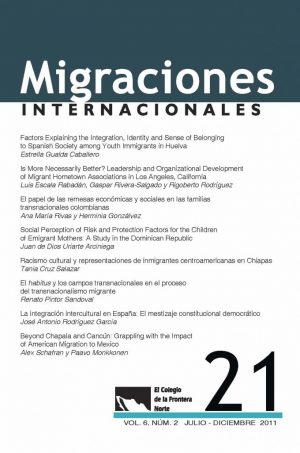Beyond Chapala and Cancún: Grappling with the Impact of American Migration to Mexico
DOI:
https://doi.org/10.17428/rmi.v6i21.758Palabras clave:
retirement migration, urban planning, tourism geographies, Mexico, United StatesResumen
Over the past two decades, a twist in the migratory relationship between Mexico and the United States has begun to attract the attention of policy makers and scholars: a growing stream of people moving permanently or semi-permanently from the United States to Mexico. Th e general understanding of this phenomenon until recently has been that these migrants are wealthy retirees moving to isolated resort-type complexes in beach cities. However, the present paper demonstrates that the migration is actually heterogeneous in terms of its people, places and impacts.
Thus, we argue that study of the phenomenon must be expanded to include not only a better understanding of the migrants themselves, but also the impacts on the receiving localities. To this end, we propose a framework for a research agenda, creating a typology of receiving places and the settlements within these places.
Más allá de Chapala y Cancún: Lidiando con el impacto de la migración estadounidense en México
Resumen
A lo largo de las dos últimas décadas, un viraje en la relación migratoria entre México y Estados Unidos ha comenzado a captar el interés de políticos e investigadores: se trata del flujo en el aumento de estadounidenses que se trasladan a vivir a México de manera temporal o permanente. Hasta hace poco, la interpretación general de este fenómeno era que se trataba de migrantes jubilados y solventes que se dirigían a centros turísticos exclusivos en diversas ciudades costeras. Este trabajo pone de manifiesto que esta migración es en extremo heterogénea en cuanto a las personas, los destinos y sus efectos.
Además argumenta que el análisis de este fenómeno debería enfocarse no sólo en los migrantes sino también en el impacto del flujo migratorio sobre las localidades receptoras. Con este fin, se propone un esquema para una nueva línea de investigación con una tipología de las localidades receptoras y sus asentamientos. Esta tipología nos permite acceder a la literatura académica para la investigación de la migración de estadounidenses a México.
Referencias
Álvarez-Rivadulla, M. J., 2007, “Golden Ghettos: Gated Communities
and Class Residential Segregation in Montevideo, Uruguay”,
Environment and Planning A, vol. 39, num. 1, pp. 47-63.
American Citizens Abroad (aca), 1999, “Myths and Facts: Including
Americans Abroad in Census 2000”. Available at
www.aca.ch/mythfac.htm> (last accessed on July 19, 2009).
Andelson, R. V., 2000, “Land-value Taxation around the World”,
American Journal of Economics and Sociology, vol. 59, num. 5,
Supplement, p. 490.
Banks, S. P., 2004, “Identity Narratives by American and Canadian
Retirees in Mexico”, Journal of Cross-Cultural Gerontology,
vol. 19, num. 4, December, pp. 361-381.
Bosque, R. L., and V. Z. Montes de Oca Zavala [conference],
, “Análisis comparado de la migración internacional de
vejez hacia España y México”, ii Congreso de la Asociación
Latinoamericana de Población, Guadalajara, Mexico, September
-5.
Brenner, L., 2005, “State-planned Tourism Destinations: The
Case of Huatulco, Mexico”, Tourism Geographies, vol. 7, num.
, pp. 138-164.
Brenner, L. and A. G. Aguilar, 2002, “Luxury Tourism and Regional
Economic Development in Mexico”, The Professional
Geographer, vol. 54, num. 4, pp. 500-520.
Caldeira, T. P. R., 2000, City of Walls: Crime, Segregation, and
Citizenship in São Paulo, Berkeley, California, University of
California Press.
Chicago Graduate School of Business News, 2007, “Mexican-U.S.
Migration could Flow Both Ways”, Chicago GSB News, Chicago,
Illinois, The University of Chicago Booth School of Business,
June 14. Available at
-14_carstens.aspx> (last accessed on June 14, 2007).
Clancy, M. J., 1999, “Tourism and Development Evidence from
Mexico”, Annals of Tourism Research, vol. 26, num. 1, pp. 1-20.
Clancy, M. J., 2000, “Mexican Tourism: Export Growth and
Structural Change since 1970”, Latin American Research Review,
vol. 36, num 1, pp. 128-150.
Coates, K. S., R. Healy and W. R. Morrison, 2002, “Tracking the
Snowbirds: Seasonal Migration from Canada to the USA and
Mexico”, American Review of Canadian Studies, vol. 32, num.
, pp. 433-452.
Collins, J. L., 2003, Threads: Gender, Labor, and Power in the
Global Apparel Industry, Chicago, Illinois, University of Chicago
Press.
Croucher, S., 2007, “‘They Love Us Here’: American Migrants
in Mexico”, Dissent, Winter. Available at
dissentmagazine.org/article/?article=723> (last accessed on July
, 2009).
Dalsgaard, T., 2000, The Tax System in Mexico: A Need for
Strength ening the Revenue-Raising Capacity, Paris, Organisation
for Economic Co-operation and Development [ECO/
WKP(2000)6. Unclassified].
Davis, M., 2006, “Mexico’s Immigration Problem (Excerpt ed from
no one Is Illegal)”, TomPaine.Com. Available at
tompaine.com/articles/2006/09/25/mexicos_immigration_
problem.php> (last accessed on September 25, 2006).
De Duren, N. L., 2006, “Planning à la carte: The Location Patterns
of Gated Communities around Buenos Aires in a Decentralized
Planning Context”, International Journal of Urban and
Regional Research, vol. 30, num. 2, pp. 308-327.
Dear, M. and A. Burridge, 2005, “Cultural Integration and Hybridization
in the United States-Mexico Borderlands”, Cahiers
de Géographie du Québec, vol. 49, num. 138, pp. 301-318.
Dear, M. J. and G. Leclerc, eds., 2003, Postborder City: Cultural
Spaces of Bajalta California”, New York, Routledge.
Dibble, S., 2002, “Foreigners could Lose Oceanfront Residences
in Mexico; Southern Baja Homes Violating Coastal Law”, The
San Diego Union-Tribune, San Diego, California, April 3, p.
B1, 2002.
Dibble, S. and L. Weisberg, 2005, “Baja’s Building Boom”, Copley
News Service, San Diego, California. Available at
signonsandiego.com/uniontrib/20051002/news_1n2rush.
html> (last accessed on October 3, 2005).
Dove J., 2007, “Tourist Impact on the Yucatán Peninsula”, Geography
Review, vol. 20, num. 5, pp. 2-4.
Enríquez Acosta, J. Á., 2008, “Segregación y fragmentación en las
nuevas ciudades para el turismo: Caso Puerto Peñasco, Sonora,
México”, Topofilia, vol. 1, num. 1. Available at
net/enriquez.html> (last accessed on July 19, 2009).
Everitt, J. et al., 2008, “The Imprints of Tourism on Puerto
Vallarta, Jalisco, Mexico”, Canadian Geographer/Le Geographe
Canadien, vol. 52, num. 1, pp. 83-104.
Freeman, L., 2006, There Goes the Hood: Views of Gentrification
from the Ground up, Philadelphia, Temple University Press.
Freeman, L. and F. Braconi, 2004, “Gentrification and Displacement:
New York City in the 1990’s”, Journal of the American
Planning Association, vol. 70, num. 1, pp. 39-52.
Gereffi, G., J. Humphrey and T. Sturgeon, 2005, “The Governance
of Global Value Chains”, Review of International Political
Economy, vol. 12, num. 1, pp. 78-104.
Gullette, G. S., 2007, “Development Economics, Developing Migration:
Targeted Economic Development Initiatives as Drivers
in International Migration”, Human Organization, vol. 66,
num. 4, pp. 366-379.
Hackworth, J., 2002, “Postrecession Gentrification in New York
City”, Urban Affairs Review, vol. 37, num. 6, pp. 815-843.
Hawley, C., 2007, “Seniors Head to Mexico for Cheaper Nursing
Care: Despite Quality Concerns, Prices Prove Appealing”, The
Arizona Republic, August 16.
Herzog, L., 2003, “Global Tijuana: The Seven Ecologies of the
Border”, in M. J. Dear and G. Leclerc, eds., Postborder City:
Cultural Spaces of Bajalta California, New York, Routledge, pp.
-142.
Holder, V. H., 1976, The Migration of Retirees to Mexico, a Survey
and Case Study of Guadalajara, Mexico, Minneapolis, Minnesota,
University of Minnesota.
Holguin, Jaime, 2004, “More Retirees Migrating South: Growing
Stream of Americans Running to Mexico”, CBS Evening
News, Playas de Rosarito, Mexico, May 19, 2004. Available at
<http://www.cbsnews.com/stories/2004/05/19/eveningnews/
main618600.shtml> (last accessed on May 1, 2011).
inegi, 1999, Censos económicos 1999, Aguascalientes, Mexico, Instituto
Nacional de Estadística y Geografía. Available at
www.inegi.org.mx/est/contenidos/espanol/proyectos/censos/
ce1999/saic/default.asp?modelo=CMAP&s=est&c=10354>
(last accessed on May 10, 2011).
Inegi, 2001, XII Censo general de población y vivienda 2000, Aguascalientes, Mexico, Instituto Nacional de Estadística y Geografía.
Johnson, R., 2007, “Taking Baja South”, Los Angeles Times,
Los Angeles, October 14. Available at <http://articles.latimes.
com/2007/oct/14/magazine/tm-bajaboom28> (last accessed on
July 19, 2009).
Kincannon, C. L., 2004, “Counting Americans Overseas: Lessons
Learned from the 2004 Overseas Enumeration Test”,
U.S. Census Bureau, U.S. House of Representatives, September
Lizárraga Morales, O., 2008a, “La inmigración de jubilados estadounidenses en México y sus prácticas transnacionales: Estudio
de caso en Mazatlán, Sinaloa y Cabo San Lucas, Baja
California Sur”, Migración y Desarrollo, num. 11, pp. 97-117.
Lizárraga Morales, O., 2008b, “Los inmigrantes estadounidenses
en Mazatlán y Los Cabos”, Arenas: Revista Sinaloense de Ciencias
Sociales, num. 16, pp. 103-115.
Lizárraga Morales, O., 2010, “The U.S. Citizens’ Retirement Migration
to Los Cabos, Mexico”, Recreation and Society in Africa,
Asia, & Latin America (RASALA), vol. 1, num. 1, pp. 75-92.
López-López, A., 2006, “Segregation of Tourist Space in Los Cabos,
Mexico”, Tourism Geographies, vol. 8, num. 4, pp. 359-379.
Lucero, H. M., 2003, “Peopling Baja California”, in M. J. Dear
and G. Leclerc, eds., 2003, Postborder City: Cultural Spaces of
Bajalta California, New York, Routledge.
Migration Policy Institute (mpi), 2006, America’s Emigrants: U.S.
Retirement Migration to Mexico and Panama. Available at
<http://www.migrationpolicy.org/pubs/americas_emigrants.
php> (last accessed on July 19, 2009).
Newman, K. and E. Wyly, 2006, “The Right to Stay Put, Revisited:
Gentrification and Resistance to Displacement in New
York City”, Urban Studies, vol. 43, num. 1, pp. 23-57.
Otero, Y. and L. Melton, 1997, “U.S. Retired Persons in Mexico”,
American Behavioral Scientist, vol. 40, num. 7, p. 914.
Pender, K., 2007, “Tales of Buying Property South of the Bord -
er”, San Francisco Chronicle, San Francisco, California,
November 11. Available at <http://articles.sfgate.com/2007-
-11/business/17268094_1_panama-central-america-healthcare>
(last accessed on July 19, 2009).
Pírez, P., 2002, “Buenos Aires: Fragmentation and Privatization
of the Metropolitan City”, Environment and Urbanization, vol.
, num. 1, April, p. 145.
Plotnicov, L., 1994, “El atractivo de ciudades medias”, Estudios
Demográficos y Urbanos, vol. 9, num. 2, pp. 283-301.
Rodríguez, V. E., 1997, Decentralization in Mexico: From Reforma
Municipal to Solidaridad to Nuevo Federalismo, Boulder,
Colorado, Westview Press.
Roy, A. and N. AlSayyad, 2004, Urban Informality: Transnational
Perspectives from the Middle East, Latin America, and South
Asia, Lanham, Maryland, Lexington Books.
Sadowski-Smith, C., 2002, Globalization on the Line: Culture,
Capital, and Citizenship at U.S. borders, New York, Palgrave
Macmillan.
Smith, N., 1996, The New Urban Frontier: Gentrification and the
Revanchist City, New York, Routledge.
Smith, N. and P. Williams, 1986, Gentrification of the City, Boston,
Massachusetts, Allen & Unwin.
Steinitz, C. et al., 2005, “Alternative Futures for the Region of
Loreto, Baja California Sur, Mexico”, report from Harvard
University’s Graduate School of Design/Universidad Autónoma
de Baja California Sur/University of Arizona/cibnor/San
Die go State University/Scripps Institute of Oceanography/Municipality
of Loreto, B. C. S., November 17.
Stokes, E. M., 1990, “Ethnography of a Social Border: The Case
of an American Retirement Community in Mexico”, Journal of
Cross-Cultural Gerontology, vol. 5, num. 2, pp. 169-182.
Sunil, T. S., V. Rojas and D. E. Bradley, 2007, “United States’
International Retirement Migration: The Reasons for Retiring
to the Environs of Lake Chapala, Mexico”, Ageing and Society,
vol. 27, num. 04, pp. 489-510.
Svampa, M., 2001, Los que ganaron. La vida en los countries y barrios
privados, Buenos Aires, Biblos.
Tamborini, C. R., 2007, “Work, Wages and Gender in Export-
Oriented Cities: Global Assembly versus International Tourism
in Mexico”, Bulletin of Latin American Research, vol. 26, num.
, pp. 24-49.
Torres R. and J. Momsen, 2005a, “Planned Tourism Development
in Quintana Roo, Mexico: Engine for Regional Development
or Prescription for Inequitable Growth?”, Current Issues
in Tourism, vol. 8, num. 4, pp. 259-285.
Torres R. and J. Momsen, 2005b, “Gringolandia: The Construction
of a New Tourist Space in Mexico”, Annals of the Association
of American Geographers, vol. 95, num. 2, pp. 314-335.
Truly, D., 2002, “International Retirement Migration and Tourism
along the Lake Chapala Riviera: Developing a Matrix of
Retirement Migration Behaviour”, Tourism Geographies, vol. 4,
num. 3, pp. 261-281.
U.S. Census Bureau, 2006, American Community Survey. Available
at (last accessed on November
, 2007).
Ward, P. M., 2004, “Informality of Housing Production at the
Urban-Rural Interface: The Not-so-Strange Case of the Texas
Colonias”, in R. Ananya and N. AlSayyad, eds., Urban Informality:
Transnational Perspectives from the Middle East, Latin
America, and South Asia, Lanham, Maryland, Lexington
Books, pp. 243-270.
Warner, D. C. and L. R. Jahnke, 2001, “Toward Better Access to
Health Insurance Coverage for U.S. Retirees in Mexico”, Salud
Pública de México, vol. 43, num. 1, pp. 59-66.
Warnes, A. M., 2001, “The International Dispersal of Pensioners
from Affluent Countries”, International Journal of Population
Geography, vol. 7, num 5, pp. 373-388.
Wilson, T. D., 2008, “Economic and Social Impacts of Tourism
in Mexico”, Latin American Perspectives, vol. 35, num. 3, p. 37.
Descargas
Publicado
Número
Sección
Licencia
Las/los autoras/es que publiquen en esta revista aceptan las siguientes condiciones:
- Las/los autoras/es conservan los derechos de autor y ceden a la revista Migraciones Internacionales (RMI) el derecho de la primera publicación, mediante el registro de los textos con la licencia de Creative Commons Atribución-No comercial-Sin derivar 4.0 internacional (CC BY-NC-ND 4.0), que permite a terceros utilizar lo publicado siempre que mencionen la autoría del trabajo y a la primera publicación en esta revista.
- Autorizan que su artículo y todos los materiales incluidos en él sean reproducidos, publicados, traducidos, comunicados y transmitidos públicamente en cualquier forma o medio; así como efectuar su distribución al público en el número de ejemplares que se requieran y su comunicación pública, en cada una de sus modalidades, incluida su puesta a disposición del público a través de medios electrónicos o de cualquier otra tecnología, para fines exclusivamente científicos, culturales, de difusión y sin fines comerciales.
- Los autores/as pueden realizar otros acuerdos contractuales independientes y adicionales para la distribución no exclusiva de la versión del artículo publicado en esta revista (por ejemplo: incluirlo en un repositorio institucional, página web personal; o bien publicarlo en un libro) siempre que sea sin fines comerciales e indiquen claramente que el trabajo se publicó por primera vez en Migraciones Internacionales (RMI), [agregando la ficha bibliográfica correspondiente: Autor/es. (año). Título del artículo. Migraciones Internacionales, volumen (número), pp. doi: xxxx ].
Para ello, las/los autoras/es deben remitir el formato de carta-cesión de la propiedad de los derechos de la primera publicación debidamente llenado y firmado. Este documento debe cargarse en formato PDF en archivos complementarios dentro de la plataforma OJS.
Este obra está bajo una licencia de Creative Commons Atribución-No comercial-Sin derivar 4.0 internacional (CC BY-NC-ND 4.0)..



 Idioma
Idioma










